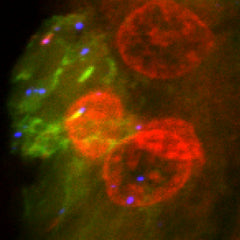A hot topic in the field of therapeutic drug delivery in the growing investigational use of nanoparticles. But, why exactly are nanoparticles so exciting when it comes to treating diseases like cancer? The answer to this question literally fills entire text books and graduate courses, however, the basic underlying theory of nanoparticle drug delivery can be explained fairly straightforward and non-technically.
Watch this short YouTube video and read on below to see how nanoparticles are effectively being used to deliver drugs.
The Goal of Using Nanoparticles to Delivery Drugs to treat Cancer
First, let’s take cancer as the target disease. This is a good example because cancer research is currently leading the way for nanoparticle delivery, offering promising developments. Cancer is defined simply as abnormal cells with uncontrolled division and growth that invade nearby tissues. Current treatments including chemotherapy and radiation kill cancer cells. However, they also kill healthy cells which often leads to the negative side-effects associated with these treatments. The goal with nanoparticle drug delivery is two-fold; first is to improve the efficacy of the drug to kill the cancer, and second is to avoid harming healthy cells. So what features of nanoparticles make them so adept at drug delivery to treat cancer?
Size Matters
Nanoparticles for drug delivery are typically 100 nm to 300 nm in size. For reference, a red blood cell is about 8 um, or 8000 nm. At 80 times smaller than a red blood cell these nanoparticle drug delivery vesicles are extraordinarily small. Because of this small size, drug loaded nanoparticles have the ability to penetrate tissues and cells more readily. For treating cancer this is especially important.
Nanoparticles Exploit Specific Characteristics of Cancer
Cancerous tumors are often characterized by what is called “leaky vasculature”. This endothelium leakiness allows therapeutic access to the tumor from the blood stream. Nanoparticles are small enough that they can sneak through these cracks in the leaky blood vessels and accumulate in the cancer cells. The preferential accumulation of nanoparticles in tumor tissue is known as the enhanced permeability and retention (EPR) effect. Once they permeate into the cancer cells, poor lymphatic drainage enhances the nanoparticle retention and accumulation over time.
Killing Cancer Without Side Effects
Drug delivery nanoparticles can exploit tumor microenvironments to deliver their therapeutic payloads, but what prevents them from also accumulating in healthy cells? First, healthy cells typically maintain much tighter endothelial junctions without leaks for nanoparticles to access. In addition to this passive characteristic, a common proactive approach to prevent off-target delivery is the attachment of targeting ligands to the nanoparticle surface. By conjugating targeting moieties, such as antibodies that are specific for receptors uniquely expressed on the surface of cancer cells, nanoparticles can be directed to specifically bind to the tumor instead of healthy cells. A common analogy is the lock and key; where the nanoparticle targeting ligand is the key, and it only fits the lock found in cancer cells.
Further, by sticking the nanoparticle onto cancer cells through targeting it initiates receptor mediated endocytosis. Thus, when a nanoparticle carrying drug binds to the target receptor on the cancer cell surface it triggers the cancer cell to internalize the foreign body, effectively delivering the drug to cytoplasm of the cancer cell. Once inside the cancer cell the drug is released from the nanoparticle vehicle and enacts its therapeutic effect to kill the tumor.
 Pictured: A thin tissue section imaged by elemental fluorescence microscopy of a rabbit liver tumor treated with nanoparticles. One hour after injection, some of the nanoparticles (blue) found their way into cells (cytoplasm in green) and cell nuclei (nuclear DNA in red). [Source: National Cancer Institute \ Lurie Comprehensive Cancer Center of Northwestern University]
Pictured: A thin tissue section imaged by elemental fluorescence microscopy of a rabbit liver tumor treated with nanoparticles. One hour after injection, some of the nanoparticles (blue) found their way into cells (cytoplasm in green) and cell nuclei (nuclear DNA in red). [Source: National Cancer Institute \ Lurie Comprehensive Cancer Center of Northwestern University]
Current and Future Promise of Nanoparticles in the Fight Against Cancer
Nanoparticles are important new tools for fighting cancer. With the promise of improving drug efficacy while also minimizing damage to non-cancerous healthy cells, it is clear why there is excitement about using nanotechnology for drug delivery. Already, the FDA has approved nanoparticle drugs for treatment of cancer, such as Abraxane for breast cancer. It is likely that going forward new technology and increased understanding of cancer biochemistry will usher in even more nanoparticles to advance the fight against cancer through improved drug delivery and therapeutic efficacy.
While this is a basic summary of nanoparticle drug delivery for cancer, the details are much more complex and are still being actively investigated. If you are curious to learn more about nanoparticle drug development you can contact NanoHybrids or investigate the latest research.
Explore More:

